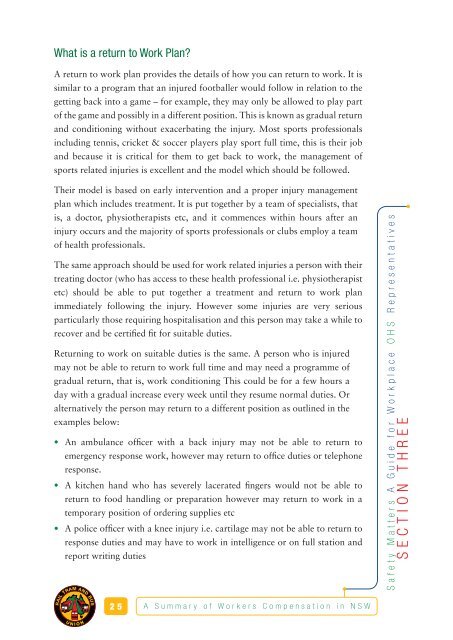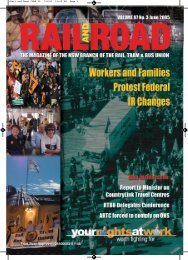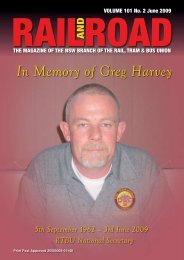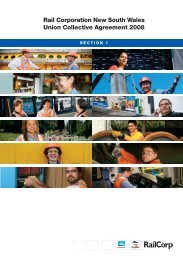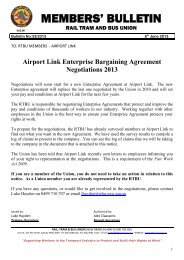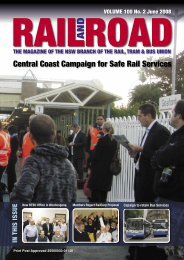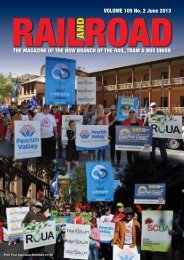Safety Matters - Rail, Tram and Bus Union of NSW
Safety Matters - Rail, Tram and Bus Union of NSW
Safety Matters - Rail, Tram and Bus Union of NSW
Create successful ePaper yourself
Turn your PDF publications into a flip-book with our unique Google optimized e-Paper software.
What is a return to Work Plan?<br />
A return to work plan provides the details <strong>of</strong> how you can return to work. It is<br />
similar to a program that an injured footballer would follow in relation to the<br />
getting back into a game – for example, they may only be allowed to play part<br />
<strong>of</strong> the game <strong>and</strong> possibly in a different position. This is known as gradual return<br />
<strong>and</strong> conditioning without exacerbating the injury. Most sports pr<strong>of</strong>essionals<br />
including tennis, cricket & soccer players play sport full time, this is their job<br />
<strong>and</strong> because it is critical for them to get back to work, the management <strong>of</strong><br />
sports related injuries is excellent <strong>and</strong> the model which should be followed.<br />
Their model is based on early intervention <strong>and</strong> a proper injury management<br />
plan which includes treatment. It is put together by a team <strong>of</strong> specialists, that<br />
is, a doctor, physiotherapists etc, <strong>and</strong> it commences within hours after an<br />
injury occurs <strong>and</strong> the majority <strong>of</strong> sports pr<strong>of</strong>essionals or clubs employ a team<br />
<strong>of</strong> health pr<strong>of</strong>essionals.<br />
The same approach should be used for work related injuries a person with their<br />
treating doctor (who has access to these health pr<strong>of</strong>essional i.e. physiotherapist<br />
etc) should be able to put together a treatment <strong>and</strong> return to work plan<br />
immediately following the injury. However some injuries are very serious<br />
particularly those requiring hospitalisation <strong>and</strong> this person may take a while to<br />
recover <strong>and</strong> be certified fit for suitable duties.<br />
Returning to work on suitable duties is the same. A person who is injured<br />
may not be able to return to work full time <strong>and</strong> may need a programme <strong>of</strong><br />
gradual return, that is, work conditioning This could be for a few hours a<br />
day with a gradual increase every week until they resume normal duties. Or<br />
alternatively the person may return to a different position as outlined in the<br />
examples below:<br />
• An ambulance <strong>of</strong>ficer with a back injury may not be able to return to<br />
emergency response work, however may return to <strong>of</strong>fice duties or telephone<br />
response.<br />
• A kitchen h<strong>and</strong> who has severely lacerated fingers would not be able to<br />
return to food h<strong>and</strong>ling or preparation however may return to work in a<br />
temporary position <strong>of</strong> ordering supplies etc<br />
• A police <strong>of</strong>ficer with a knee injury i.e. cartilage may not be able to return to<br />
response duties <strong>and</strong> may have to work in intelligence or on full station <strong>and</strong><br />
report writing duties<br />
<strong>Safety</strong> <strong>Matters</strong> A Guide for Workplace OHS Representatives<br />
SECTION THREE<br />
RAIL<br />
TRAM AND BUS<br />
25<br />
A Summary <strong>of</strong> Workers Compensation in <strong>NSW</strong><br />
U N<br />
I O N


